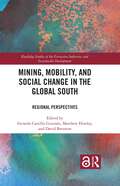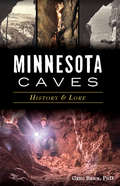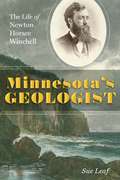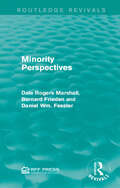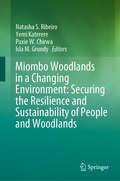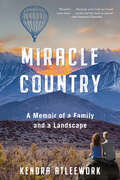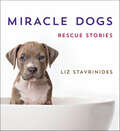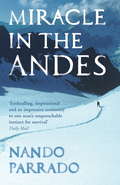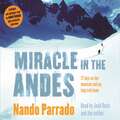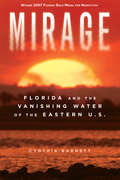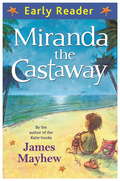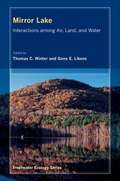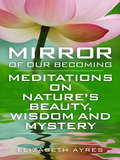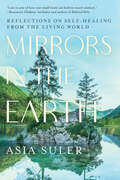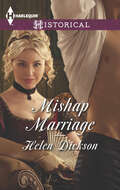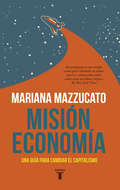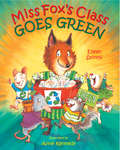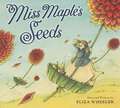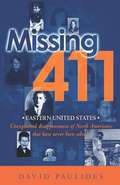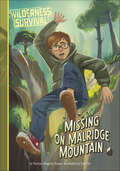- Table View
- List View
Mining, Mobility, and Social Change in the Global South: Regional Perspectives (Routledge Studies of the Extractive Industries and Sustainable Development)
by Matthew Himley Gerardo Castillo Guzmán David BreretonThis volume focuses on how, why, under what conditions, and with what effects people move across space in relation to mining, asking how a focus on spatial mobility can aid scholars and policymakers in understanding the complex relation between mining and social change. This collection centers the concept of mobility to address the diversity of mining-related population movements as well as the agency of people engaged in these movements. This volume opens by introducing both the historical context and conceptual tools for analyzing the mining-mobility nexus, followed by case study chapters focusing on three regions with significant histories of mineral extraction and where mining currently plays an important role in socio-economic life: the Andes, Central and West Africa, and Melanesia. Written by authors with expertise in diverse fields, including anthropology, development studies, geography, and history, case study chapters address areas of both large- and smallscale mining. They explore the historical-geographical factors shaping mining-related mobilities, the meanings people attach to these movements, and the relations between people’s mobility practices and the flows of other things put in motion by mining, including capital, ideas, technologies, and toxic contamination. The result is an important volume that provides fresh insights into the social geographies and spatial politics of extraction. This book will be of great interest to students and scholars of mining and the extractive industries, spatial politics and geography, mobility and migration, development, and the social and environmental dimensions of natural resources more generally.
Mining, Mobility, and Social Change in the Global South: Regional Perspectives (Routledge Studies of the Extractive Industries and Sustainable Development)
by Matthew Himley Gerardo Castillo Guzmán David BreretonThis volume focuses on how, why, under what conditions, and with what effects people move across space in relation to mining, asking how a focus on spatial mobility can aid scholars and policymakers in understanding the complex relation between mining and social change. This collection centers the concept of mobility to address the diversity of mining-related population movements as well as the agency of people engaged in these movements. This volume opens by introducing both the historical context and conceptual tools for analyzing the mining-mobility nexus, followed by case study chapters focusing on three regions with significant histories of mineral extraction and where mining currently plays an important role in socio-economic life: the Andes, Central and West Africa, and Melanesia. Written by authors with expertise in diverse fields, including anthropology, development studies, geography, and history, case study chapters address areas of both large- and smallscale mining. They explore the historical-geographical factors shaping mining-related mobilities, the meanings people attach to these movements, and the relations between people’s mobility practices and the flows of other things put in motion by mining, including capital, ideas, technologies, and toxic contamination. The result is an important volume that provides fresh insights into the social geographies and spatial politics of extraction. This book will be of great interest to students and scholars of mining and the extractive industries, spatial politics and geography, mobility and migration, development, and the social and environmental dimensions of natural resources more generally.
Minnesota Caves: History & Lore
by Greg BrickMinnesota’s caves have a deep history. Carver’s Cave is the first to be described in the literature of North America after explorer Jonathan Carver visited it in 1766. The storied Fountain Cave was the birthplace of the city of St. Paul. Just after the American Civil War, Chute’s Cave inspired an elaborate national hoax regarding an ancient civilization. Folklore surrounds Petrified Indian Cave, where a strangely shaped stalagmite was mistaken for a person turned to stone. Geologist and urban explorer Greg Brick, PhD, uses decades of research to uncover the secrets of geological wonders.
Minnesota's Geologist: The Life of Newton Horace Winchell
by Sue LeafWinner of the 2021 Minnesota Book Award for Minnesota Nonfiction The story of the scientist who first mapped Minnesota&’s geology, set against the backdrop of early scientific inquiry in the state At twenty, Newton Horace Winchell declared, &“I know nothing about rocks.&” At twenty-five, he decided to make them his life&’s work. As a young geologist tasked with heading the Minnesota Geological and Natural History Survey, Winchell (1839–1914) charted the prehistory of the region, its era of inland seas, its volcanic activity, and its several ice ages—laying the foundation for the monumental five-volume Geology of Minnesota. Tracing Winchell&’s remarkable path from impoverished fifteen-year-old schoolteacher to a leading light of an emerging scientific field, Minnesota&’s Geologist also recreates the heady early days of scientific inquiry in Minnesota, a time when one man&’s determination and passion for learning could unlock the secrets of the state&’s distant past and present landscape.Traveling by horse and cart, by sailboat and birchbark canoe, Winchell and his group surveyed rock outcrops, river valleys, basalt formations on Lake Superior, and the vast Red River Valley. He studied petrology at the Sorbonne in Paris, bringing cutting-edge knowledge to bear on the volcanic rocks of the Arrowhead region. As a founder of the American Geological Society and founding editor of American Geologist, the first journal for professional geologists, Winchell was the driving force behind scientific endeavor in early state history, serving as mentor to many young scientists and presiding over a household—the Winchell House, located on the University of Minnesota&’s present-day mall—that was a nexus of intellectual ferment. His life story, told here for the first time, draws an intimate picture of this influential scientist, set against a backdrop of Minnesota&’s geological complexity and splendor.
Minority Perspectives (Routledge Revivals)
by Dale Rogers Marshall Bernard Frieden Daniel Wm. FesslerOriginally published in 1972, Minority Perspectives is the second in a series exploring metropolitan problems within the government structure. The 1960’s were a period of civils rights movements as well as poverty in the United States and in the 70’s, it became clear that poverty was closely linked to race. This report sets out to explore issues contributing to the metropolitan-minority poverty problem such as racial exclusion and public policy. The papers included in this report discuss issues such as political power in metropolitan areas, the impact an address can have on economic opportunity for minority groups and the effects that laws and litigation can have on poverty. This title will be of interest to students of environmental and urban studies.
Minus 148 Degrees: First Winter Ascent of Mt. McKinley
by Art DavidsonArt Davidson recounts the exciting adventures of the first winter ascent of Mt. McKinley in Alaska.
Miombo Woodlands in a Changing Environment: Securing the Resilience and Sustainability of People and Woodlands
by Yemi Katerere Natasha S. Ribeiro Paxie W. Chirwa Isla M. GrundyBased on work by the Miombo Network in southern Africa, this book helps decision-makers and general readers alike improve their understanding of the socio-ecology of the Miombo woodlands across southern Africa. It also highlights the importance of and the need for further research on the unique Miombo ecology and its link with economic development. One major challenge facing these woodlands is the influence that direct (both natural and anthropogenic) and indirect drivers of change, as well as interactions between these, have had over the centuries. As such the book explores the socio-economic and ecological interactions that occur in these woodlands and discusses the need for further research to provide a better understanding of these interactions.Drawing on data and information from numerous studies conducted in the last 20 years, the book presents a comparative analysis of policy changes and management experiences in the countries concerned. It also addresses issues of global climate change, since they have an impact on Miombo ecosystem management and restoration, and provides future projections based on an assessment of how climate change has affected the Miombo woodlands in the past.
Miracle Country: A Memoir
by Kendra Atleework&“Blending family memoir and environmental history, Kendra Atleework conveys a fundamental truth: the places in which we live, live on—sometimes painfully—in us. This is a powerful, beautiful, and urgently important book.&” —Julie Schumacher, author of Dear Committee Members and The Shakespeare Requirement Kendra Atleework grew up in Swall Meadows, in the Owens Valley of the Eastern Sierra Nevada, where annual rainfall averages five inches and in drought years measures closer to zero. Kendra&’s parents taught their children to thrive in this beautiful, if harsh, landscape, prone to wildfires, blizzards, and gale-force winds. Above all, they were raised on unconditional love and delight in the natural world. After Kendra&’s mother died of a rare autoimmune disease when Kendra was just sixteen, however, her once beloved desert world came to feel empty and hostile, as climate change, drought, and wildfires intensified. The Atleework family fell apart, even as her father tried to keep them together. Kendra escaped to Los Angeles, and then Minneapolis, land of tall trees, full lakes, water everywhere you look. But after years of avoiding her troubled hometown, she realized that she needed to come to terms with its past and present and had to go back. Miracle Country is a moving and unforgettable memoir of flight and return, emptiness and bounty, the realities of a harsh and changing climate, and the true meaning of home. For readers of Cheryl Strayed, Terry Tempest Williams, and Rebecca Solnit, this is a breathtaking debut by a remarkable writer.
Miracle Dogs: Rescue Stories
by Liz Stavrinides78 million dogs live as pets in the USA. These are the lucky ones. Five to seven million companion animals enter shelters every year, and more than half are euthanized due to the lack of space. Miracle Dogs celebrates and honors the rescuers and the dogs whose lives they've saved. It features wonderful stories and photographs of dog rescuers, dog trainers, and rescue organizations such as The Gentle Barn and Tamar Geller's Operation Heroes and Hounds, along with celebrity pet owners such as Chevy Chase, Hoda Kotb, Bob Einstein, Amanda Hearst, Jamie Lynn Siegler, and Lance Bass. Each story includes portraits of the dog and its new family, followed by a concise, compelling narrative detailing the dog's journey to its new home.A professional pet photographer, Liz Stavrinides spends much of her time on projects related to animal rescue. Miracle Dogs was born out of her desire to collect and share the stories of the dogs she's met over the years, showcasing the incredible bravery and compassion of both canines and owners. Readers will be moved by stories like that of Wyatt, an assistance dog who helped a young boy with autism communicate with the outside world, or Fiona, who was found blind and starving and is now in a loving family. All of them have finally found their furever homes. Stavrinides' portraits are heartwarming—a loving and poignant tribute to man's best friend.
Miracle In The Andes: 72 Days on the Mountain and My Long Trek Home
by Nando ParradoIn October 1972, Nando Parrado and his rugby club teammates were on a flight from Uruguay to Chile when their plane crashed into a mountain. Miraculously, many of the passengers survived but Nando's mother and sister died and he was unconscious for three days.Stranded more than 11,000 feet up in the wilderness of the Andes, the survivors soon heard that the search for them had been called off - and realise the only food for miles around was the bodies of their dead friends ...In a last desperate bid for safety, Nando and a teammate set off in search of help. They climbed 17,000-foot-high mountains, facing death at every step, but inspired by his love for his family Nando drove them on until, finally, 72 days after the crash, they found rescue.
Miracle In The Andes: 72 Days on the Mountain and My Long Trek Home
by Nando ParradoWhen Nando Parrado took off on a flight from Uruguay to Chile with his rugby team-mates, he was looking forward to an enjoyable weekend break, and had invited his mother and sister along for the trip. Then disaster struck, as their plane crashed into a mountain. Miraculously, many of the passengers survived, but Nando's family died and he was unconscious for three days. Stranded 11,000 feet up on an inhospitable glacier, the survivors had almost no food or suitable equipment to withstand temperatures as low as -40C. Meagre supplies rapidly diminished, and soon they heard on the radio that the search for them had been called off. It was then that they realised the only food for miles around was the bodies of their dead friends... In a final, desperate bid for safely, Nando and one of his friends set off on an impossible journey, climbing 17,000 feet-high mountains, facing death at every step. Finally, on the twelfth day of their journey, and 72 days after the crash, they saw a hill farmer and the survivors found rescue.Read by Nando Parrado and Josh Davis(p) 2006 Orion Publishing Group
Mirage: Florida and the Vanishing Water of the Eastern U.S.
by Cynthia BarnettPart investigative journalism, part environmental history, Mirage reveals how the eastern half of the nation--historically so wet that early settlers predicted it would never even need irrigation--has squandered so much of its abundant fresh water that it now faces shortages and conflicts once unique to the arid West. Florida's parched swamps and supersized residential developments set the stage in the first book to call attention to the steady disappearance of fresh water in the American East, from water-diversion threats in the Great Lakes to tapped-out freshwater aquifers along the Atlantic seaboard. Told through a colorful cast of characters including Walt Disney, Jeb Bush and Texas oilman Boone Pickens, Mirage ferries the reader through the key water-supply issues facing America and the globe: water wars, the politics of development, inequities in the price of water, the bottled-water industry, privatization, and new-water-supply schemes. From its calamitous opening scene of a sinkhole swallowing a house in Florida to its concluding meditation on the relationship between water and the American character, Mirage is a compelling and timely portrait of the use and abuse of freshwater in an era of rapidly vanishing natural resources. Cynthia Barnett, a reporter for Florida Trend magazine, has been a newspaper and magazine journalist for twenty years. Her numerous journalism awards include three investigative-reporting prizes in the Green Eyeshades, which recognize the best journalism in eleven southeastern states. In 2004, she was awarded a Knight-Wallace Fellowship at the University of Michigan, where she spent a year studying freshwater supply. She lives in Gainesville, Florida.
Miranda the Castaway (Early Reader)
by James MayhewEarly Readers are stepping stones from picture books to reading books. A blue Early Reader is perfect for sharing and reading together. A red Early Reader is the next step on your reading journey.Miranda is on a desert island - all by herself! Luckily she has some very clever ideas...A full-colour blue Early Reader edition of this classic story, written and illustrated by James Mayhew.
Mirror Lake: Interactions Among Air, Land, and Water
by Thomas C. Winter Gene E. LikensLakes change constantly in response to their surrounding landscape, and their airshed. Mirror Lake, located in the White Mountains of New Hampshire, has been carefully researched since the 1960s. This book, edited by Thomas C. Winter and Gene E. Likens, summarizes and interprets the extensive data collected on this lake and its watershed from 1981 to 2000, a period during which the lake was affected by a variety of climate conditions as well as significant human activity. The findings documented also identify the panoply of chemicals influenced by limnological processes and include percentages of inflow sources, percentages of water loss from seepage, surface outflow, and evaporation, and the effect of water flow on the lake nutrients.
Mirror of Our Becoming: Meditations on Nature's Beauty, Wisdom and Mystery
by Elizabeth AyresHow often does your mirror say, "You are beautiful, you are wise, you are loved?" "Mirror of Our Becoming: Meditations on Nature's Beauty, Wisdom and Mystery" is a collection of contemplative reflections revealing the reality of your existence: that the beauty around you is already inside you. It will show you how to align yourself with that grand tapestry in which you're a single, essential thread. It will prove you're infinitely lovable, inexhaustibly loving, and tenderly held by love's great purpose as revealed through Nature's wonders. Organized by season, this inspiring gathering of short yet deeply spiritual essays will carry you through an entire year, providing courage in times of trouble, satisfaction in times of joy. In these pages, you will know a healing communion with your inmost self, with the world, and with that divine and holy mystery to which we give many names. This volume includes a discussion guide for readers, with questions to help you, your family and your friends enjoy your own encounters with Nature more fully. There's also a study guide for aspiring writers. We cannot see our own faces. In graceful, elegant prose, this book of ecospiritual meditations shows us who we are and what we can become, because the beauty, wisdom and mystery in which we dwell is the truth that dwells within us. Beatrice Bruteau, author of "The Grand Option," says, "Ayres' poetic nature writing transforms ordinary perceptions into mystic beauty." Thomas Berry, author of "The Great Work," says, "Ayres' earth-centered spirituality shows amazing breadth of thought."
Mirrors in the Earth: Reflections on Self-Healing from the Living World
by Asia SulerA nature therapy session for the soul--encounter the benevolence of the living world through 12 essays on the Earth-healing powers of self-compassion and empathy.When healing is needed at the deepest level, nature will always call us back home--not only to the oak woods or water-filled coves, but to the homes within ourselves.In a series of 12 lyrical nature essays, herbalist, writer, and Earth intuitive Asia Suler illuminates the healing power of the living Earth--and gives us permission to nurture self-compassion and empathy as forces for personal and ecological healing.In a time of unprecedented ecological devastation, it&’s easy to feel hopeless and disconnected. It&’s easier still to mask our inherent goodness--to imagine that our unique and precious gifts simply aren&’t enough, or forget the power of our inborn empathy. For those of us who are highly sensitive, innately attuned to the workings and whispers of the natural world, it can be hard to embody the belief that we&’re enough as we are--and that can heal the Earth.Here, Suler reveals the opposite: our goodness, our empathy, our intuitive connections, and our capacity for self-compassion are more than personal traits or antidotes to despair: they are, in fact, our most potent vehicles for planetary transformation. And as we learn to more deeply nurture and accept ourselves, we unlock living, healing connections to Earth.Combining poetic nature writing with exercises and reflection prompts at the end of each essay, Mirrors in the Earth coaxes us to come as we are: to discover and tend the inherent brilliance and medicine that lives in each of us. From the manatee-calm springs of wild Florida to the flower-dotted coves of the world&’s most biodiverse mountains, Mirrors in the Earth is an invitation and encounter with the benevolence of the living world--and a nature therapy session for the soul.
Mishap Marriage
by Helen DicksonA sea captain’s marriage ploy leads to unexpected adventure with a Caribbean heiress in this sexy historical romance.Caribbean Islands, 1800. When Captain Zack Fitzgerald sails into the island of Santamaria, the arrival of his ship causes a stir among the inhabitants. For Shona McKenzie, whose father rules the island—and her life—with an iron fist, the ruggedly handsome captain offers an appealing ticket to freedom. But her sister-in-law’s scheming places them in a highly compromising situation.Although Zack is mesmerized by Shona, marriage would destroy his plans to obtain guardianship over his child, so he devises a plan to make sure the forced wedding stays a sham. But weeks later Shona shows up on his London doorstep, and Zack must learn to deal with a very unexpected, very defiant wife. . . .
Misión economía: Una guía para cambiar el capitalismo
by Mariana Mazzucato¿Y si aplicáramos a nuestros problemas actuales el espíritu, la audacia y los medios que nos llevaron a la Luna? Una crítica contundente y muy necesaria del capitalismo moderno en la que la galardonada economista internacional sostiene que, para resolver las crisis a las que nos enfrentamos, debemos ser innovadores. Llegar a la Luna fue un extraordinario logro que requirió nuevas formas de colaboración entre los sectores público y privado, un altísimo nivel de compromiso y coordinación y la aceptación de riesgos y gastos muy elevados para alcanzar una meta a largo plazo. Inspirándose en las misiones del programa lunar, Mazzucato propone que se aplique ese mismo nivel de innovación a una serie de objetivos sociales, económicos y políticos clave con el fin de salir de nuestro estancamiento rumbo a un futuro más optimista. El capitalismo lleva tiempo paralizado y no ofrece respuestas a nuestros mayores problemas, como las epidemias, la desigualdad y la crisis ambiental. Se impone la necesidad de repensar el papel de los Estados en la economía y la sociedad, de orientar los presupuestos al largo plazo y de recuperar el sentido del interés público. Misión economía, cuyas ideas ya se están adoptando en todo el mundo, propone fijarse unos objetivos inspiradores e ilusionantes, entre los que se incluyen una prosperidad ampliamente compartida, unos servicios públicos de calidad para todos y una solución a la crisis climática. Según Mazzucato, los Estados pueden afrontar grandes desafíos y misiones ambiciosas, y su visión ofrece una salida a nuestro inmovilismo hacia un futuro más optimista. La crítica ha dicho...«Su propuesta es tan amplia como poco habitual: un nuevo relato convincente sobre cómo crear un futuro deseable.»The New York Times «Su defensa de un nuevo enfoque es abrumadora. Nos contagia con el tipo devisión, ambición e imaginación que tan desesperadamente necesitamos hoy.»The Guardian «Una visión oportuna y optimista. Aunque presenta sus argumentos de manera tan clara que pueden parecer obvios, lo cierto es que son revolucionarios.»Nature «Mazzucato sostiene que las sociedades deben abjurar de ideologías agotadas y adoptar el enfoque político que llevó a los astronautas en la Luna. Convincente y fascinante.»The Economist «Mazzucato critica la pobreza de la idea de que el único papel del gobierno es corregir las "fallas del mercado". Aboga por un sector público capaz de adaptarse a circunstancias cambiantes y nuevos desafíos.»Prospect «Mazzucato propone rediseñar el capitalismo a favor de las partes interesadas más que de los accionistas.»The Times «Desde 1969 nos preguntamos cómo los humanos pudieron llegar a la Luna y no logran resolver los problemas apremiantes aquí en la Tierra. Mariana Mazzucato ofrece la respuesta.»Financial Times «Una de las más ágiles pensadoras post-Brexit.»The Daily Mail «Según Mazzucato, años de privatizar empresas estatales y subcontratar servicios esenciales han dejado a los gobiernos debilitados e incapaces de beneficiar a la sociedad. Es el momento de que respalden objetivos audaces.»Reuters
Miss Fox's Class Goes Green
by Eileen Spinelli Anne KennedyWhen Miss Fox shows up at school riding her bicycle, Mouse asks, "Do you have a flat tire?" "No," Miss Fox tells her students. "I am going green!" Soon everyone in the class is working to keep the earth healthy. Mouse takes shorter showers (and does her singing after!); Bunny brings a cloth bag to the supermarket; and Possum turns the lights off when he goes out. And Miss Fox's simple act has ripples even beyond her own students . . . the principal starts riding his bike, too, and soon the whole school is going green! As in Peace Week in Miss Fox's Class, Eileen Spinelli and Anne Kennedy have combined their talents to make a serious subject both funny and inspiring.
Miss Maple's Seeds
by Eliza WheelerFans of Miss Rumphius will adore this gorgeous picture book which introduces the kind, nature-loving Miss Maple, who celebrates the miracle in each seed.Miss Maple gathers lost seeds that haven’t yet found a place to sprout. She takes them on field trips to explore places to grow. In her cozy maple tree house, she nurtures them; keeping them safe and warm until it's time for them to find roots of their own, and grow into the magnificent plants they’re destined to become.Eliza Wheeler’s luminous paintings feature gorgeous landscapes, lush foliage and charming details. Her tender story celebrates the potential found in each seed—since even the grandest tree and most brilliant flower had to grow from the smallest of seeds.Celebrate every season with Miss Maple, from Earth Day to graduations to harvest festivals.
Miss Rumphius
by Barbara CooneyA beloved classic—written by a beloved Caldecott winner—is lovelier than ever!Barbara Cooney's story of Alice Rumphius, who longed to travel the world, live in a house by the sea, and do something to make the world more beautiful, has a timeless quality that resonates with each new generation. The countless lupines that bloom along the coast of Maine are the legacy of the real Miss Rumphius, the Lupine Lady, who scattered lupine seeds everywhere she went. Miss Rumphius received the American Book Award in the year of publication.To celebrate the thirtieth anniversary of two-time Caldecott winner Barbara Cooney's best-loved book, the illustrations have been reoriginated, going back to the original art to ensure state-of-the-art reproduction of Cooney's exquisite artwork. The art for Miss Rumphius has a permanent home in the Bowdoin College Museum of Art.
Missing 411 - Western United States and Canada: Unexplained Disappearances in North Americas That Have Never Been Solved
by David PaulidesMissing-411 is the first comprehensive book about people who have disappeared in the wilds of North America. It's understood that people routinely get lost, some want to disappear but this story is about the unusual. Nobody has ever studied the archives for similarities, traits and geographical clusters of missing people, until now. A tip from a national park ranger led to this three year, 7000+ hour investigative effort into understanding the stories behind people who have vanished. The book chronicles children, adults and the elderly who disappeared, sometimes in the presence of friends and relatives. As Search and Rescue personnel exhaust leads and places to search, relatives start to believe kidnappings and abductions have occurred. The belief by the relatives is not an isolated occurrence; it replicates itself time after time, case after case across North America. The research depicts 28 clusters of missing people across the continent, something that has never been exposed and was a shocking find to researchers. Topography does play a part into the age of the victims and certain clusters have specific age and sex consistency that is baffling. This is not a phenomenon that has been occurring in just the last few decades, clusters of missing people have been identified as far back as the 1800's. The manuscript for the research was extremely large so the story was split between two books, Missing 411 Western United States and Canada and Missing 411 Eastern United States. The Eastern version will be released in late March and will include a list of all missing people in each edition and a concluding chapter that draws both books together for conclusions. Some of the issues that are discussed in each edition:* The National Park Service attitude toward missing people* How specific factors in certain cases replicate themselves in different clusters* Exposing cases involving missing children that aren't on any national database* Unusual behavior by bloodhounds/canines involved in the search process* How storms, berries, swamps, briar patches, boulder fields and victim disabilities play a role in the disappearance* The strategies of Search and Rescue personnel need to change under specific circumstances Major news organizations do a deplorable job of coveringstories and issues which are deemed too unusualor too far outside the box. Chances are, they will find a wayto trivialize or ignore the disturbing evidence accumulatedby David Paulides, a former lawman turned investigativejournalist. The paper trail uncovered by Paulides throughsheer doggedness is impressive, the evidence indisputable. People are vanishing without a trace from our nationalparks and forests, yet government agencies are saying nothing. At a minimum, this story deserves space on the frontpage of every newspaper in the country, and it warrants aformal high level inquiry by the federal agencies whose files leave little doubt that something very strange is unfolding in our wilderness. George Knapp, Host, Coast to Coast AM-After reading this book, you will forever walk in the woods with a different awareness.
Missing 411- Eastern United States: Unexplained Disappearances of North Americans That Have Never Been Solved
by David PaulidesPeople have been disappearing under mysterious circumstances for centuries. During the last 150 years the media has covered many of these cases and has attempted to put a rational spin on a very unusual event. After 3+ years and 7000 hours of intensive research there is a new paradigm being presented on people missing in the wilds of North America. "Missing 411" identifies 28 clusters of missing people who have vanished in remote areas of the continent. The finding is a troubling fact questioning why and how these people have disappeared. Some of the victims are found and tell a very interesting and mind bending story of their experience, others are never found, a fact that confounds searchers and law enforcement. There are many children that have disappeared under highly unusual circumstances. After weeks of searching and failing to find any evidence of the child being in a remote location, many parents and law enforcement draw the conclusion that the victim was kidnapped, yes, taken by someone lurking in remote areas of our national parks, forests, farms and even ranches. There are two editions of this research, "Missing 411-Eastern United States" and "Missing 411-Western United States. " The eastern United States copy has a list of every person who is listed in each book as well as a final conclusion to the investigation. You will be shocked by the lack of interest and documentation that many of our governmental bodies have committed to missing people. After reading these books you will never look at our wildlands the same. Major news organizations do a deplorable job of covering major stories and issues which are deemed too unusual or too far outside the box. Chances are, they will find a way to trivialize or ignore the disturbing evidence accumulated by David Paulides, a former law man turned investigative journalist. The paper trail uncovered by Paulides through sheer doggedness is impressive, the evidence indisputable. People are vanishing without a trace from our national parks and forests, yet government agencies are saying nothing. At a minimum, this story deserves space on the front page of every newspaper in the country, and it warrants a formal high level inquiry by the federal agencies whose files leave little doubt that something very strange is unfolding in our wilderness. "George Knapp, Host, Coast to Coast AM
Missing on Malridge Mountain (Wilderness Survival)
by Thomas Kingsley TroupeWhen a quick hike up Malridge Mountain becomes a maze to get back down, Slater has to face all kinds of dangers to get off the mountain and back to his family.
Missing on Malridge Mountain (Wilderness Survival)
by Thomas Kingsley TroupeWhen Slater convinces his family to stop at Arrowhead Trail on Malridge Mountain on the way to his aunt and uncle's house, he's disappointed when his younger brother's complaining quickly ends their hike. But Slater figures he can take a quick hike up the trail before his family is ready to leave the next morning. However, Slater's hike up to a beautiful view becomes a disastrous trip back down when he tries to recover his dropped cell phone and can't get back on the trail. To get back to his family, Slater will have to work his way down the mountain battling bad weather, hunger, a few falls, and one close encounter.
